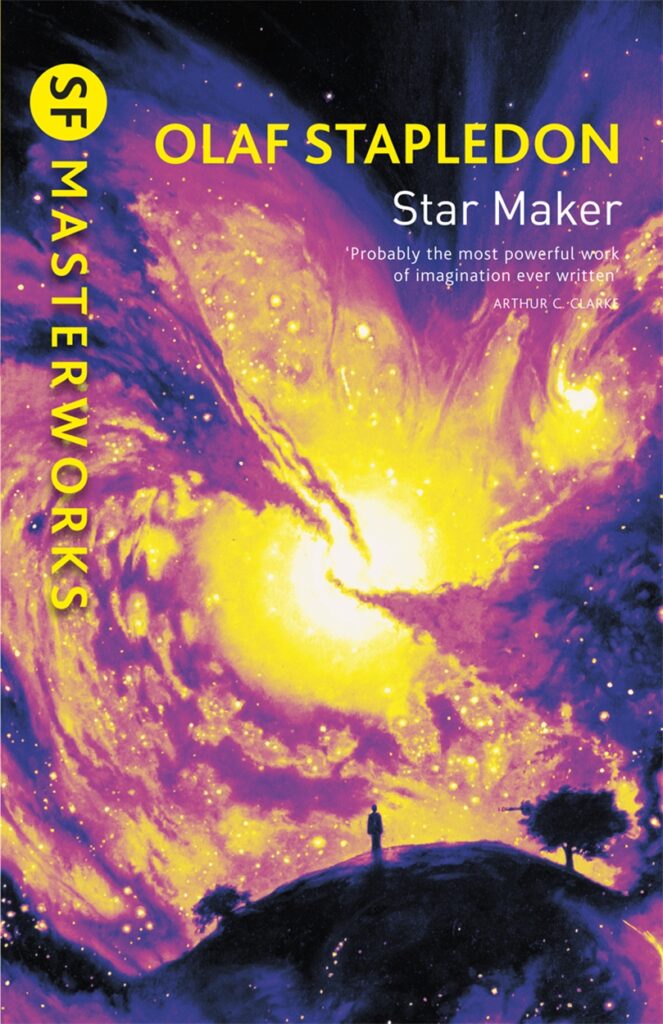Vintage Science Fiction Month is the brainchild of the Little Red Reviewer. The objective: Read and discuss “older than I am” Science Fiction in the month of January.
Info-Dumps inhabit a unique place in Science Fiction. Much maligned and discouraged by conventional standards, they nonetheless serve an informative need that might otherwise be impossible in a traditional narrative. Obviously this can be done well and it can be done poorly, not everyone can be Greg Egan or Neal Stephenson, and in a very real sense it often conflicts with admirable rules of thumb like “show, don’t tell.”
There are some tricks that can hide the worldbuilding in the very mind of the reader by implying rather than baldly stating information. The typical example of this is when you encounter the phrase “ground car” in a science fiction story. There’s an obvious meaning here, a car that drives on the ground just like many of us ride in every day, but the inclusion of “ground” as a modifier implies not just the existence of other modes of transportation (most likely an “air car”) but potentially entire worlds that can be unlocked (including, for example, differences in architecture or how accessibility of previously difficult terrain changes, and so on). Eric S Raymond explains how these SF words indicate prototype worlds, delves deeply into what makes them work, and how this operations within the works of the genre, but the ultimate point is that science fiction operates on information and as such, info-dumps, even ones cleverly implied by previously established jargon are a key part of the genre.

I say all of this because Olaf Stapledon’s 1938 Star Maker is less of a novel than an extended info-dump. A man gazes at the stars one night only to find himself hurtling through the firmament, a disembodied mind exploring the cosmos, stumbling on alien cultures, and traveling beyond galactic boundaries, eventually to glimpse the eponymous Star Maker, an inveterate and eternal tinkerer who has been creating each cosmos with more ambition than the last.
All of this basically takes the form of a sorta fictional Athropological text, part memoir, part travelogue (I suppose the more accurate term would be Xenology). Stylistically stripped down, simplistic, and conversational in tone, it’s not really a fast-paced page-turner, but neither is it bland or boring. This is why info-dumps are generally frowned upon in the first place, but on the other hand, the idea quotient is astounding. There’s a massive amount of imagination on display as Stapleton cycles through observations of astronomical features, exoplanets, alien life (humanoid at first, but then stretching boundaries to all manner of strange consciousnesses, galactic societies, utopias, and eventually even alternative cosmoses.)
The sheer quantity of novel ideas on display is impressive. Stapledon covers a lot of ground and popularizes if not originates numerous concepts that would become famous genre tropes later. For example, Freeman Dyson credits his idea of a hypothetical megastructure that surrounds a star and captures a large percentage of its solar power output to Star Maker, even suggesting it be called a Stapledon Sphere (it’s now known as a Dyson Sphere). That example is also illustrative of the fact that Stapledon was writing this before the terminology or jargon was even invented. He touches on things like the Many Worlds Interpretation of quantum mechanics, the Great Filter, and the Dark Forest Hypothesis, even if he didn’t have the words to describe it. And I’m only really scratching the surface here. There are a ton of big ideas that originate from this book. The only thing that isn’t particularly well captured are computers and artificial intelligence (and associated speculations like the Technological Singularity, etc…), but that’s a topic that wasn’t particularly well explored in science fiction for another 30ish years (and even those early examples were rudimentary compared to later efforts).
More surprising is how spiritual the book can get. Stapledon was an agnostic, but the yearning for meaning and utopia that is present here is essentially a religious impulse. When the titular Star Maker appears, it’s portrayed in conflicting terms as indifferent yet somehow also loving, but also at its core: unknowable. Our humble narrator is overwhelmed by the task of describing it using our imperfect language, and essentially leaves it at that. Still, he describes many an alternative cosmos, including one that is basically Judeo-Christian in nature: a universe that consists of successive phases where lives end in one phase and reappear in another (there are two alternative secondary phases that could be described as heaven and hell). Stapledon’s story doesn’t entirely resolve anything here – you could see this as a a Turtles all the way down type of situation – and as such, there are some who could consider this view of God as heretical. For instance, C.S. Lewis, in a letter to Arthur C. Clarke, famously quipped that Star Maker “ends in sheer devil worship.” I wouldn’t go quite that far, but the spiritual endgame of the universe is something you don’t see often in science fiction.
It’s a fascinating, seemingly foundational work of science fiction. It doesn’t necessarily dive deeply into every concept, but it prefigures much of what would come after. It’s not really a beginner’s text, nor is it a fast-paced page-turner, but it’s not impenetrable either. Very much worth seeking out for students of the genre and a perfect example of the sort of thing Vintage SF Month is all about.